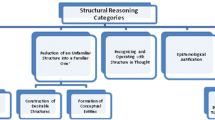Abstract
We provide evidence that student representations can serve different purposes in the context of classroom problem solving. A strategy used expressly to solve a problem might be represented in one way, and in another way when the problem is generalized or extended, and yet in another way when the solution strategy is explained to peers or a teacher. We discuss the apparent long-term memory implications this has regarding the preferences that students have for their original versus later developed representations, and how these preferences relate to the use of representational flexibility in classroom settings.














Similar content being viewed by others
Notes
The material contained herein is based upon work supported by the U.S. National Science Foundation (NSF) under grant numbers 0138806 (The Newark Public Schools Systemic Initiative in Mathematics) and ESI-0333753 (MetroMath: The Center for Mathematics in America’s Cities). Any opinions, findings and conclusions or recommendations are those of the authors and do not necessarily reflect the views of the NSF, Rutgers University or the Newark Public Schools.
References
Beishuizen, M., van Putten, C. M., & van Mulken, F. (1997). Mental arithmetic and strategy use with indirect number problems up to one hundred. Learning and Instruction, 7(1), 87–106. doi:10.1016/S0959-4752(96)00012-6.
Carey, D. A. (1991). Number sentences: Linking addition and subtraction word problems and symbols. Journal for Research in Mathematics Education, 22(4), 266–280. doi:10.2307/749272.
Cohen, N. J. (1984). Preserved learning capacity in amnesia: Evidence for multiple memory systems. In N. Butters & L. R. Squire (Eds.), The neuropsychology of memory (pp. 83–103). New York: Guildford Press.
Eichenbaum, H. (2002). The cognitive neuroscience of memory. Oxford: Oxford University Press.
Gray, E. M., & Tall, D. O. (1994). Duality, ambiguity and flexibility: A proceptual view of simple arithmetic. Journal for Research in Mathematics Education, 26(2), 115–141.
Hatano, G. (2003). Foreword. In A. J. Baroody & A. Dowker (Eds.), The development of arithmetic concepts and skills (pp. xi–xiii). Mahwah, NJ: Lawrence Erlbaum Associates.
Heirdsfield, A. M., & Cooper, T. J. (2002). Flexibility and inflexibility in accurate mental addition and subtraction: Two case studies. The Journal of Mathematical Behavior, 21, 57–74. doi:10.1016/S0732-3123(02)00103-7.
Karmiloff-Smith, A. (1994). Precis of beyond modularity: A developmental perspective on cognitive science. The Behavioral and Brain Sciences, 17(4), 693–745.
Karmiloff-Smith, A. (1995). Beyond modularity: A developmental perspective on cognitive science. Cambridge, MA: The MIT Press.
Klein, T., & Beishuizen, M. (1994). Assessment of flexibility in mental arithmetic. In J. E. H. van Luit (Ed.), Research on learning and instruction of mathematics in kindergarten and primary school. Doetinchem: Graviant Publishing Company.
National Council of Teachers of Mathematics. (2000). Principles and standards for school mathematics. Reston, VA: National Council of Teachers of Mathematics.
Ormrod, J. E. (2004). Human learning (4th ed. ed.). Upper Saddle River, NJ: Pearson.
Perkins, D. N., & Salomon, G. (1992). Transfer of learning. International encyclopedia of education (2nd ed.). Oxford: Pergamon Press.
Schorr, R. Y., Warner, L. B., Geahart, D., & Samuels, M. (2007). Teacher development in a large urban district: The impact on students. In R. Lesh, J. Kaput, & E. Hamilton (Eds.), Real-world models and modeling as a foundation for future mathematics education (pp. 431–447). Mahwah, NJ: Lawrence Erlbaum Associates.
Shore, B. M., Pelletier, S., & Kaizer, C. (1990). Metacognition, giftedness, and mathematical thinking. Budapest: European Council for High Ability.
Squire, L. R., & Kandel, E. R. (2008). Memory: From mind to molecules. Greenwood Village, CO: Roberts & Co.
Star, J. R., & Rittle-Johnson, B. (2008). Flexibility in problem solving: The case of equation solving. Learning and Instruction, 18, 565–579.
Stigler, J. W., & Hiebert, J. (1999). The teaching gap—Best ideas from the world’s teachers for improving education in the classroom. New York: The Free Press.
Thorndike, E. L., & Woodworth, R. S. (1901). The influence of improvement in one mental function upon the efficiency of other functions. Psychological Review, 8, 247–261. doi:10.1037/h0074898.
Threlfall, J. (2002). Flexible mental calculation. Educational Studies in Mathematics, 50, 29–47. doi:10.1023/A:1020572803437.
Tulving, E. (1985). Elements of episodic memory (Oxford Psychology Series). New York: Oxford University Press.
Tulving, E., & Craik, F. I. M. (2000). The Oxford handbook of memory. New York: Oxford University Press.
Vakali, M. (1984) Children’s thinking in arithmetic word problem solving. Journal of Experimental Education, 53(2), 106–113.
Verschaffel, L., Luwel, K., Torbeyns, J., & Van Dooren, W. (2009). Conceptualizing, investigating and enhancing adaptive expertise in elementary mathematics education. European Journal of Psychology of Education, 24(3), 335–359.
Warner, L. B., Davis, G. E., Alcock, L. J., & Coppolo, J. (2002). Flexible mathematical thinking and multiple representations in middle school mathematics. Mediterranean Journal for Research in Mathematics Education, 1(2), 37–61.
Acknowledgments
The authors would like to thank the editor and three anonymous reviewers for a number of invaluable suggestions.
Author information
Authors and Affiliations
Corresponding author
Rights and permissions
About this article
Cite this article
Warner, L.B., Schorr, R.Y. & Davis, G.E. Flexible use of symbolic tools for problem solving, generalization, and explanation. ZDM Mathematics Education 41, 663–679 (2009). https://doi.org/10.1007/s11858-009-0190-8
Accepted:
Published:
Issue Date:
DOI: https://doi.org/10.1007/s11858-009-0190-8




